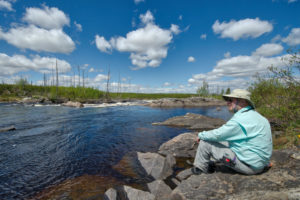Bow Open Spaces Officer Completes Canoe Trip Expedition in the Wilds of Canada
On July 2, Doug Merriman and I reached Peawanuck Village-the final stop of our 500-mile canoe expedition down the Pipestone and Winisk Rivers to Hudson Bay. It took us 23 days to paddle the remote rivers of this extensive boreal forest. Other than the First Nations bands in Wunnummin, Summer Beaver and Webequie we didn’t see anyone the entire trip.

Eric Thum, during his epic canoe trip.
Numerous sets of violent rapids and falls tested our river running expertise. If the rapids were too dangerous to attempt in the canoe, we portaged on trails which were mostly overgrown. Many times, we had to cut a trail using a Garmin InReach GPS. We would first tag the best route with surveyor tape, then hack a rough path with machetes to clear the trail. Then we made another two trips to carry the canoe and packs. Hard work indeed! We saw moose, wolverine, wolves, caribou, beaver, otter and even a polar bear. Other than one subspecies of grizzly bear, polar bears are the only animal that will stalk and eat a human. One single swipe of the claw can be enough to kill you.
Loons, geese, bufflehead, eagles, cranes, sandpipers, terns, jays (whiskey jack), and thrush were spotted on and off the Shield. The white-throated sparrow was ubiquitous-in the early morning, at lunch stops or late evening we heard its clear high whistle: Old Sam Peabody Peabody Peabody. Terns would hover over our canoe, emit a loud harsh kraa, and then dive in the water to catch fish. From my stern seat I marveled at the incredible flight patterns of this slender bird.
Perhaps the most memorable moment of our trip was the landscape transition from the rocky shores of the Shield to the Hudson Bay Lowlands near the end of our trip. The Lowlands is a vast, flat, sodden plain abutting Hudson and James Bays. Glacial and marine deposits left by the glaciers and ancient seas change the landscape to marshy and gravel banks. The pervasive black spruce, balsam and aspen give way to low-lying alder and willow thickets. The rapids were very choppy and extensive gravel bars made us zigzag endlessly to find the best way through the rough water. Right before our finish point at Peawanuck Village we stopped to take pictures of immense limestone cliffs towering over the Winisk. The skies opened up to reveal a magnificent yellow sun between enormous cumulus clouds.
It was a fitting end to a successful adventure in the great north woods of Canada.
A proposed project called Ring of Fire may drastically change this landscape forever. It is a proposed 5,120 square kilometer chromite ore mining development worth an estimated 6.2 billion. New roads and towns, transmission lines, and noise and air pollution will affect the peace and solitude of this vast area just southeast of where we paddled in the Winisk Wild River Provincial Park. Perhaps Doug and I will be some of the last canoeists to enjoy the unspoiled beauty of northern Ontario.
(Eric Thum, September, 2019)
Trackback from your site.




